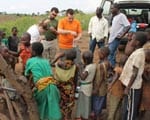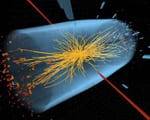Technology designed to detect nuclear explosions and enforce the world’s nuclear test-ban treaty now will be pioneered to monitor active volcanoes in the Northern Mariana Islands near Guam. The island of Guam soon will be the primary base for forward deployment of U.S. military forces in the Western Pacific.
The two-year, $250,000 project of the U.S. Geological Survey and Southern Methodist University will use infrasound — in addition to more conventional seismic monitoring — to “listen” for signs a volcano is about to blow. The plan is to beef up monitoring of lava and ash hazards in the Northern Mariana Islands, a U.S. commonwealth.
The archipelago’s active volcanoes threaten not only residents of the island chain and the U.S. military, but also passenger airlines and cargo ships.
The USGS project calls for installing infrasound devices alongside more traditional volcano monitoring equipment — seismometers and global positioning systems.

Scientists at SMU, which the USGS named the prime cooperator on the project, will install the equipment and then monitor the output via remote sensing. The project is a scientific partnership of the USGS, SMU and the Marianas government.
An infrasound experiment
Infrasound hasn’t been widely used to monitor volcanoes, according to noted volcano expert and SMU geology professor James E. Quick, who is project chief. Infrasound can’t replace seismometers but may help scientists interpret volcanic signals, Quick said.
“This is an experiment to see how much information we can coax out of the infrasound signal,” he said. “My hope is that we’ll see some distinctive signals in the infrasound that will allow us to discriminate the different kinds of eruptive styles — from effusive events that produce lava flows, or small explosive events we call vulcanian eruptions, to the large ‘Plinian’ events of particular concern to aviation. They are certain to have some characteristic sonic signature.”
SMU geologists in recent decades pioneered the use of infrasound to monitor nuclear test-ban compliance, and they continue to advance the technology. For the USGS project, they’ll install equipment on three of the Marianas’ 15 islands. In the event magma begins forcing its way upward, breaking rocks underground and ultimately erupting, seismometers will measure ground vibrations throughout the process, GPS will capture any subtle changes or deformities in the surface of the Earth, and infrasound devices will record sound waves at frequencies too low to be heard by humans. Infrasound waves move slower than the speed of light but can travel for hundreds of miles and easily penetrate the earth as well as other material objects.
Volcanoes active on nine islands
Nine Mariana islands have active volcanoes. On average, the archipelago experiences about one eruption every five years, said Quick, who was previously program coordinator of the USGS Volcano Hazards Program.
Most recently a volcano erupted in 2005 on the island of Anatahan, the largest historical eruption of that volcano, according to the USGS. It expelled some 50 million cubic meters of ash, the USGS reported, noting at the time that the volcanic plume was “widespread over the western Philippine Sea, more than 1300 nautical miles west of Anatahan.” A volcano that erupted on the island of Pagan in 1981 has been showing many signs of unrest, Quick said.
Besides the USGS volcano project, SMU has been active in the Marianas through a memorandum of agreement to help the local government search for alternative energy sources, in particular geothermal.
The Marianas volcano project is part of a larger USGS program that is investing $15.2 million of American Recovery and Reinvestment Act funds to boost existing monitoring of high-risk volcanic areas in partnership with universities and state agencies nationwide.
US military deploying to nearby Guam
In targeting the Marianas, the USGS cited the evacuation of residents from the northern islands after the 1981 eruption on Pagan, as well as the threat to the main island of Saipan and to nearby Guam. A U.S. territory, Guam is expected to be home to about 40,000 U.S. military and support personnel by 2014, including 20,000 Marines and dependents redeployed from Okinawa. The Marines will use the island as a rapid-response platform for both military and humanitarian operations. The military also has proposed using the Northern Marianas for military exercises.
The USGS cited also the threat of volcanic ash plumes to commercial and military planes. Air routes connect Saipan and Guam to Asia and the rest of the Pacific Rim, as well as Northeast Asia to Australia, Indonesia, the Philippines and New Zealand.
Worldwide from 1970 to 2000 more than 90 commercial jets have flown into clouds of volcanic ash, causing damage to those aircraft, most notably engine failure, according to airplane maker Boeing.
Volcanic ash hazard to aircraft
Volcanic ash plumes can rise to cruise altitudes in a matter of minutes after an eruption, Quick said. Winds carry plumes thousands of miles from the volcanoes, he explained, and then the plumes are difficult or impossible to distinguish from normal atmospheric clouds.
Monitoring by remote sensing allows USGS scientists to alert the International Civil Aviation Organization’s nine Volcanic Ash Advisory Centers as part of ICAO’s International Airways Volcano Watch program. The centers then can issue early warnings of volcanic ash clouds to pilots.
“Monitoring on the ground gives early warning when an eruption begins, as well as an indication that an eruption might be imminent,” Quick said. “The contribution by the USGS and its university partners for volcano monitoring is to provide that earliest warning — or even a pre-eruption indication — that a volcano is approaching eruption so that the volcanic ash advisory centers can get the word out and alerts can be issued.”
The USGS objective is for infrasound on Saipan, four seismometers on Anatahan, which currently has only one functioning seismometer, two seismometers on Sarigan, and GPS on Anatahan, Sarigan and Saipan.
Safer for residents
Improved monitoring, Quick said, even might allow evacuated islanders to return to their homes — especially understandable for the island of Pagan, given its freshwater lakes, lush forests, black and white sand beaches and abundant fishing.
“A lot of people would like to move back, but it’s considered unsafe absent monitoring,” he said. “If we can establish monitoring networks on these islands, then I think it becomes more practical for people to think about returning. Properly monitored, one should be able to give adequate warning so that people could evacuate.”
Quick is a professor in the SMU Roy M. Huffington Department of Earth Sciences as well as associate vice president for research and dean of graduate studies at SMU. — Margaret Allen
SMU is a nationally ranked private university in Dallas founded 100 years ago. Today, SMU enrolls nearly 11,000 students who benefit from the academic opportunities and international reach of seven degree-granting schools. For more information see www.smuresearch.com. Follow SMU Research on Twitter, @smuresearch.
SMU has an uplink facility located on campus for live TV, radio, or online interviews. To speak with an SMU expert or book an SMU guest in the studio, call SMU News & Communications at 214-768-7650.

 Human diabetes has new research tool: Overfed fruit flies that develop insulin resistance
Human diabetes has new research tool: Overfed fruit flies that develop insulin resistance
 SMU to help solve dangerous refugee water issues
SMU to help solve dangerous refugee water issues




 Ancient tree-ring records from southwest U.S. suggest today’s megafires are truly unusual
Ancient tree-ring records from southwest U.S. suggest today’s megafires are truly unusual



